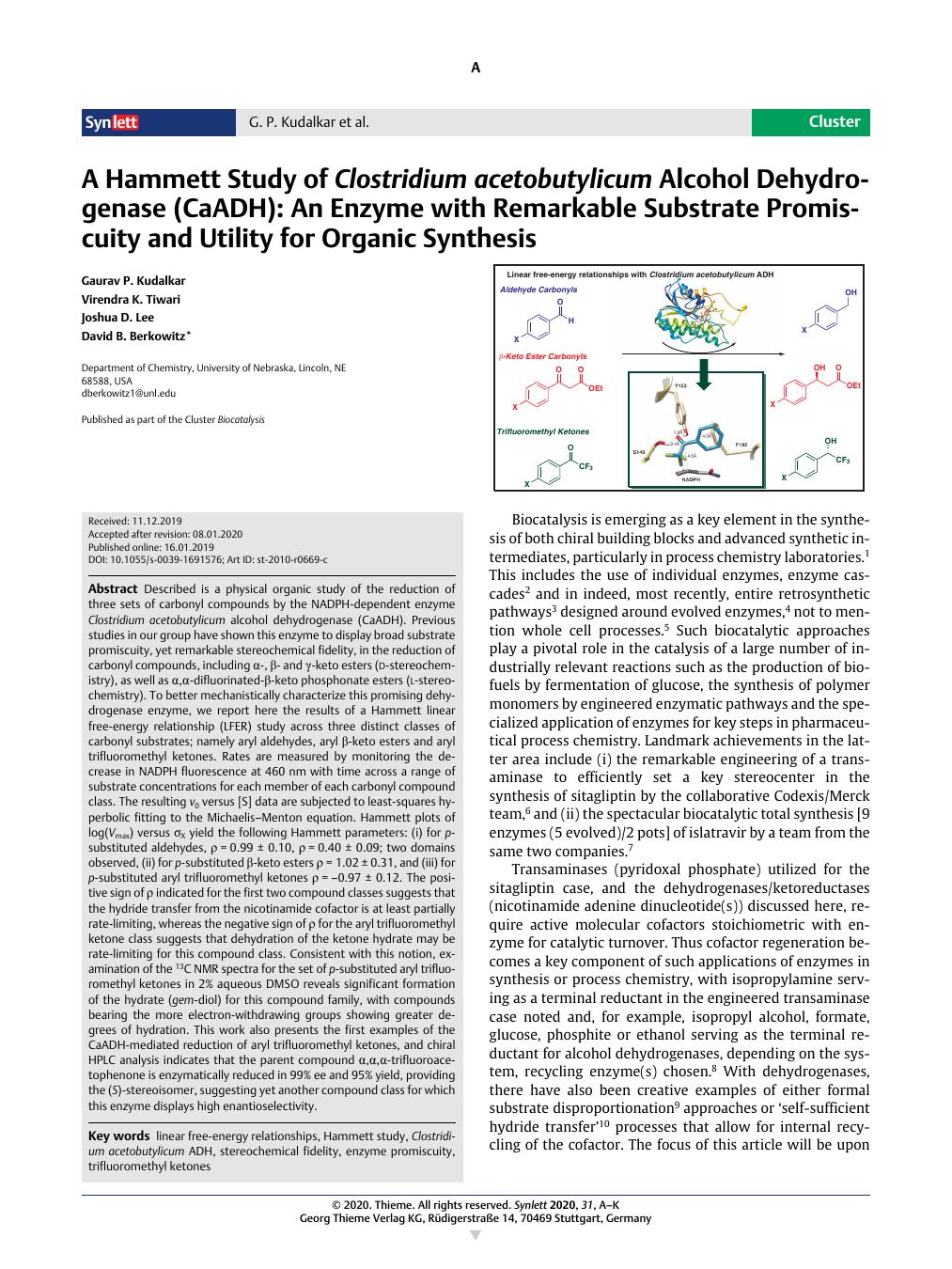Our official English website, www.x-mol.net, welcomes your feedback! (Note: you will need to create a separate account there.)
A Hammett Study of Clostridium acetobutylicum Alcohol Dehydrogenase (CaADH): An Enzyme with Remarkable Substrate Promiscuity and Utility for Organic Synthesis
Synlett ( IF 2 ) Pub Date : 2020-01-16 , DOI: 10.1055/s-0039-1691576 Gaurav P. Kudalkar , Virendra K. Tiwari , Joshua D. Lee , David B. Berkowitz 1
Synlett ( IF 2 ) Pub Date : 2020-01-16 , DOI: 10.1055/s-0039-1691576 Gaurav P. Kudalkar , Virendra K. Tiwari , Joshua D. Lee , David B. Berkowitz 1
Affiliation

|
Described is a physical organic study of the reduction of three sets of carbonyl compounds by the NADPH-dependent enzyme Clostridium acetobutylicum alcohol dehydrogenase (CaADH). Previous studies in our group have shown this enzyme to display broad substrate promiscuity, yet remarkable stereochemical fidelity, in the reduction of carbonyl compounds, including α-, β- and γ-keto esters ( d -stereochemistry), as well as α,α-difluorinated-β-keto phosphonate esters ( l -stereochemistry). To better mechanistically characterize this promising dehydrogenase enzyme, we report here the results of a Hammett linear free-energy relationship (LFER) study across three distinct classes of carbonyl substrates; namely aryl aldehydes, aryl β-keto esters and aryl trifluoromethyl ketones. Rates are measured by monitoring the decrease in NADPH fluorescence at 460 nm with time across a range of substrate concentrations for each member of each carbonyl compound class. The resulting v 0 versus [S] data are subjected to least-squares hyperbolic fitting to the Michaelis–Menton equation. Hammett plots of log(V max) versus σX yield the following Hammett parameters: (i) for p-substituted aldehydes, ρ = 0.99 ± 0.10, ρ = 0.40 ± 0.09; two domains observed, (ii) for p-substituted β-keto esters ρ = 1.02 ± 0.31, and (iii) for p-substituted aryl trifluoromethyl ketones ρ = –0.97 ± 0.12. The positive sign of ρ indicated for the first two compound classes suggests that the hydride transfer from the nicotinamide cofactor is at least partially rate-limiting, whereas the negative sign of ρ for the aryl trifluoromethyl ketone class suggests that dehydration of the ketone hydrate may be rate-limiting for this compound class. Consistent with this notion, examination of the 13C NMR spectra for the set of p-substituted aryl trifluoromethyl ketones in 2% aqueous DMSO reveals significant formation of the hydrate (gem-diol) for this compound family, with compounds bearing the more electron-withdrawing groups showing greater degrees of hydration. This work also presents the first examples of the CaADH-mediated reduction of aryl trifluoromethyl ketones, and chiral HPLC analysis indicates that the parent compound α,α,α-trifluoroacetophenone is enzymatically reduced in 99% ee and 95% yield, providing the (S)-stereoisomer, suggesting yet another compound class for which this enzyme displays high enantioselectivity.
中文翻译:

丙酮丁醇梭菌乙醇脱氢酶 (CaADH) 的哈米特研究:一种具有显着底物混杂性和有机合成效用的酶
描述了通过 NADPH 依赖性酶丙酮丁醇梭菌醇脱氢酶 (CaADH) 还原三组羰基化合物的物理有机研究。我们小组先前的研究表明,这种酶在还原羰基化合物(包括 α-、β- 和 γ-酮酯(d-立体化学)以及 α,α)方面表现出广泛的底物混杂性和显着的立体化学保真度-二氟化-β-酮膦酸酯(l-立体化学)。为了更好地表征这种有前景的脱氢酶,我们在此报告了对三种不同类型羰基底物进行的哈米特线性自由能关系 (LFER) 研究的结果;即芳基醛、芳基β-酮酯和芳基三氟甲基酮。通过监测每个羰基化合物类别的每个成员的底物浓度范围内 460 nm 处 NADPH 荧光随时间的减少来测量速率。所得的 v 0 与 [S] 数据经过对 Michaelis-Menton 方程的最小二乘双曲线拟合。log(V max) 与 σX 的哈米特图产生以下哈米特参数:(i) 对于 p 取代醛,ρ = 0.99 ± 0.10,ρ = 0.40 ± 0.09;观察到两个域,(ii) 对于 p-取代的 β-酮酯 ρ = 1.02 ± 0.31,和 (iii) 对于 p-取代的芳基三氟甲基酮 ρ = –0.97 ± 0.12。前两个化合物类别的 ρ 的正号表明来自烟酰胺辅因子的氢化物转移至少是部分限速的,而芳基三氟甲基酮类的 ρ 的负号表明酮水合物的脱水可能是此类化合物的限速。与此观点一致,对 2% DMSO 水溶液中一组对位取代的芳基三氟甲基酮的 13C NMR 谱的检查揭示了该化合物家族的水合物(宝石二醇)的显着形成,其中化合物具有更多的吸电子性水化程度更高的组。这项工作还展示了 CaADH 介导的芳基三氟甲基酮还原的第一个例子,手性 HPLC 分析表明母体化合物 α,α,α-三氟苯乙酮以 99% ee 和 95% 的产率被酶促还原,提供 (S )-立体异构体,
更新日期:2020-01-16
中文翻译:

丙酮丁醇梭菌乙醇脱氢酶 (CaADH) 的哈米特研究:一种具有显着底物混杂性和有机合成效用的酶
描述了通过 NADPH 依赖性酶丙酮丁醇梭菌醇脱氢酶 (CaADH) 还原三组羰基化合物的物理有机研究。我们小组先前的研究表明,这种酶在还原羰基化合物(包括 α-、β- 和 γ-酮酯(d-立体化学)以及 α,α)方面表现出广泛的底物混杂性和显着的立体化学保真度-二氟化-β-酮膦酸酯(l-立体化学)。为了更好地表征这种有前景的脱氢酶,我们在此报告了对三种不同类型羰基底物进行的哈米特线性自由能关系 (LFER) 研究的结果;即芳基醛、芳基β-酮酯和芳基三氟甲基酮。通过监测每个羰基化合物类别的每个成员的底物浓度范围内 460 nm 处 NADPH 荧光随时间的减少来测量速率。所得的 v 0 与 [S] 数据经过对 Michaelis-Menton 方程的最小二乘双曲线拟合。log(V max) 与 σX 的哈米特图产生以下哈米特参数:(i) 对于 p 取代醛,ρ = 0.99 ± 0.10,ρ = 0.40 ± 0.09;观察到两个域,(ii) 对于 p-取代的 β-酮酯 ρ = 1.02 ± 0.31,和 (iii) 对于 p-取代的芳基三氟甲基酮 ρ = –0.97 ± 0.12。前两个化合物类别的 ρ 的正号表明来自烟酰胺辅因子的氢化物转移至少是部分限速的,而芳基三氟甲基酮类的 ρ 的负号表明酮水合物的脱水可能是此类化合物的限速。与此观点一致,对 2% DMSO 水溶液中一组对位取代的芳基三氟甲基酮的 13C NMR 谱的检查揭示了该化合物家族的水合物(宝石二醇)的显着形成,其中化合物具有更多的吸电子性水化程度更高的组。这项工作还展示了 CaADH 介导的芳基三氟甲基酮还原的第一个例子,手性 HPLC 分析表明母体化合物 α,α,α-三氟苯乙酮以 99% ee 和 95% 的产率被酶促还原,提供 (S )-立体异构体,



























 京公网安备 11010802027423号
京公网安备 11010802027423号